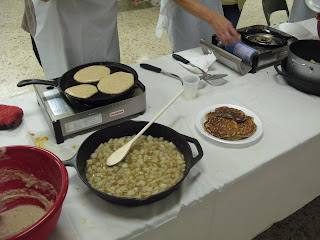Butternut squash cooking in a pot
The Philippi Healthy Families Initiative hosts cooking demonstrations in Philippi that are targeted towards families. They recently hosted one on the 14th, and WesMonTy was able to attend.
These great workshops are funded though the DHHR Healthy Lifestyles office which received a grant through the CDC. Philippi is allowed the funding because it is a Mainstreet Community. Davis Memorial Hospital also supports this project through funding of equipment and providing expertise of their clinical nutritionist a RD/CDE.
They market the program through the local elementary school by handing out a flyer to each student. The child accompanied by one parent must register ahead of time in order to participate. This week there were 24 registered, with 30 being the limit.
Even this late in the season, the class was accomplished with some produce by a local grower. Several things were provided by Mark Hollen. He provided the root vegetables for the homework, the butternut squash for the Squash Mash and the corn meal for the pancakes. The cornmeal is something special, it was hand-ground and produced from a variety of corn that is organically grown abenaki calais. This is a strain that was raised by the abanaki indians in New England by the time the pilgrims arrived.
All the produce waste is also collected and composted. This is a good lesson in the energy cycle and the resuse of these products.
The cooking work is accomplished through the mobile kitchen units: gas stoves, utensils and all the kitchen supplies needed for food prep. They arranged six stations, with 4 or 5 families and one assistant per station.

Kitchen Utensils

Gas Stoves
Using the menu for the week, they prepare the food using the mobile kitchen. In between food prep, the children sit down to watch a video on nutrition.
Making the pancakes and the pear topping
Watching the nutrition video
When the food is all prepared, they clear the table, set it and eat as a family.
Setting the table for a family dinner!
At the very end they get 'homework', which is a bag of food to take home and prepare by the instructions. In this case it was a bag of root vegetables with a recipe for Roasted Root Vegetables. Each family also gets an incentive gift. The gifts are given with practicality in mind. For instance, this class they received a pancake pan, and previously they have received measuring cups and pumpkin muffin tins.
During the class, the instructors teach about food safety, food preparation, and for the children how to measure, prepare and cook the foods.
Measuring out the ingredients for the ranch dip
The children had a great time getting to work with the food and learning about the food preparation. Using toothpicks and chopped veggies, the children also made 'Veggie Robots', a fun little way to prepare and eat the vegetables.
A completed Veggie Robot
Some delicious Ranch Dressing
This weeks menu was:
1. Squash Mash
2. Ranch Dip
3. Warm Ginger Pear Topping
4. Cornmeal Wheat Pancakes
5. Veggie Robot














